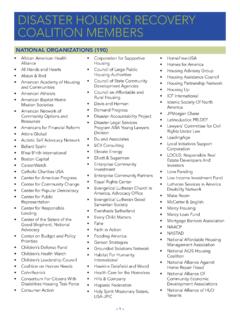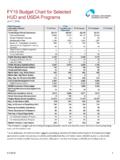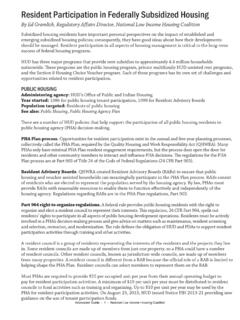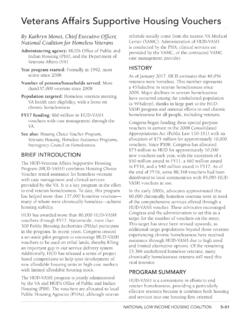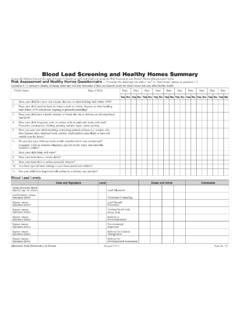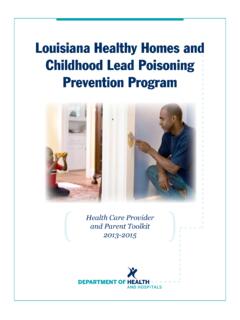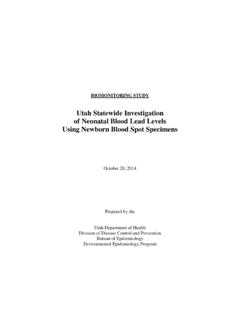Transcription of Lead Hazard Control and Healthy Homes - nlihc.org
1 5 6 2016 ADVOCATES GUIDEBy Julie Kruse, Director of Policy, National Center for Healthy Housing Administering agency: HUD s Office of Lead Hazard Control and Healthy Homes (OLHCHH)Year program started: Lead Hazard Control , 1992; Healthy Homes Initiative, 1999 Population targeted: Low income and very low income families who reside in worst-quality private housing where children under six years of age reside or are likely to funding: $110 MillionIndoor pollution and hazards inside our Homes typically pose far greater risks to children s health than outdoor exposure. This is due to the fact that children spend as much as 90% of their time indoors, and toxic substances can reach more concentrated levels indoors than they do outside. Older, dilapidated housing with lead-based paint, and the dust and soil it generates, are the biggest sources of lead exposure for children.
2 Often these units have a combination of health dangers that include dust mites, molds, and pests that can cause or trigger asthma; carcinogens, such as asbestos, radon, and pesticides; and other deadly toxins such as carbon monoxide. HISTORY AND PURPOSELead Hazard Control . The Residential Lead-Based Paint Hazard Reduction Act, or Title X of the Housing and Community Development Act of 1992, was enacted to focus the nation on making housing safe for children by preventing exposure to lead-based paint that has deteriorated due to moisture problems and poor maintenance, and invisible lead dust caused by repair and painting work that disturbs lead-based paint. The law established the Lead Hazard Control Grants Program to provide grants to communities to Control lead-based paint hazards in privately owned, low income, owner-occupied and rental housing.
3 In 2003, Congress created Lead Hazard Reduction Demonstration Grants to target additional lead Hazard Control grants to the nation s highest-risk cities. Both programs and enforcement of related regulations are housed in HUD s OHHLHC. Healthy Homes Initiative. The Healthy Homes Initiative was established by HUD in 1999 to protect children and their families from residential health and safety hazards. The goal of this program is a comprehensive, integrated approach to housing hazards through grants that create and demonstrate effective, low-cost methods of addressing mold, lead, allergens, asthma, carbon monoxide, home safety, pesticides, and radon. These grant programs are housed in HUD s beneficiaries of the lead Hazard Control program are low income households.
4 Assisted rental units served must be made available on a priority basis for at least three years for families with children under age six. Ninety percent of owner-occupied units served must house or be regularly visited by a child under age six. Because the funds do not cover all housing eligible under federal policy, each grantee develops its local plan and is permitted to target investment of grant funds based on factors such as the presence of a lead-poisoned child and location in a high-risk neighborhood. The programs funds are awarded via a competitive combined Notice of Fund SUMMARYR ecent research confirms that housing policy has a profound impact on public health, and for any public health agenda to be effective, it must include a housing component.
5 The statistics and key findings regarding the long-term effects of housing-related health hazards are alarming. More than 500,000 children under five in the have elevated blood lead levels. Childhood exposure to lead can have lifelong consequences including decreased cognitive function, developmental delays, behavior problems, and, at very high levels can cause seizures, coma, and even death. Asthma is the single most common chronic condition among children in the ; 26 million people in the have asthma, including of children under 18. In 2007-2008, the economic costs to society of lead poisoning and asthma were estimated at $50 billion and $56 billion respectively. Lead Hazard Control and Healthy Homes5 7 NATIONAL LOW INCOME HOUSING COALITIONThe burden of housing-related health hazards falls disproportionately on the most vulnerable children and communities, contributing greatly to health disparities.
6 African-American children are twice as likely to have asthma and are six times more likely to die from it than white children. Households with annual incomes less than $30,000 are twice as likely as others to have lead hazards in their Homes . Children of low income families are eight times more likely to be lead-poisoned than those of higher income families, and African-American children are five times more likely than whites to be lead-poisoned. Children poisoned by lead are seven times more likely to drop out of school, and six times more likely to end up in the juvenile justice numbers begin to add up to even bigger consequences when dealing with the cumulative effects of multiple hazards. Inadequate ventilation increases the concentration of lethal indoor air pollutants such as radon and carbon monoxide, and exacerbates moisture and humidity problems.
7 Moisture causes paint deterioration, which puts children at risk of exposure to leaded dust and paint chips. Moisture also encourages growth of mold, mildew, dust mites, and microbes, which contribute to asthma and other respiratory diseases. Asthma is exacerbated by allergic reaction to certain triggers such as dust, mold, pests (such as cockroaches, rats, and mice), cold air, and dry heat. Use of common pesticides to Control infestations contaminates Homes with known carcinogens. Thus, a whole-house approach is critical including thorough visual assessments, air tests, and remediation , solutions and opportunities may arise through existing weatherization and rehabilitation work. Since improperly disturbing lead-based paint may cause lead poisoning, it is necessary to use lead-safe work practices and comply with EPA s renovation rule.
8 Many weatherization treatments have Healthy Homes benefits. For example, window replacement can help with lead poisoning prevention, and roof repair and insulation may help reduce moisture intrusion and prevent mold. Improving ventilation to ameliorate the ill effects of tightening a building can help ensure no harm from energy-efficiency SUMMARY Programs based at HUD include: Healthy Homes Initiative. The Healthy Homes Demonstration Grant Program develops, demon-strates and promotes cost-effective, preventive measures for identifying and correcting residential health and safety hazards. HUD awards Healthy Homes Demonstration grants to not-for profits, for-profit firms located in the , state and local governments, federally recognized Indian Tribes, and colleges and Healthy Homes Technical Studies grant program develops and improves cost-effective methods for evaluating and controlling residential health and safety hazards through a separate competition open to academic and nonprofit institutions, state and local governments, tribes, and for-profit organizations.
9 Lead Hazard Control Grants. The typical award of $3 million addresses hazards in several hundred Homes and provides needed outreach and capacity-building services. Grants can only be awarded to states, counties, and cities for lead Hazard Control in private housing. At least 65% of the grant must be used for direct activities such as abatement, interim Control , clearance, and risk assessment. Grantees are required to partner with community groups, typically by awarding sub-grants, and to provide a match of 10%-25% from local or Community Development Block Grant (CDBG) funds. More than $1 billion has been awarded since the program started in 1993. Lead Hazard Reduction Demonstration Grants. This program targets funds for lead Hazard Control to the nation s 100 highest-risk cities as defined by the prevalence of lead poisoning and the number of pre-1940 rental housing units.
10 Grants may be as high as $4 million, but 80% of the funds must be spent on direct activities, and HUD requires a 25% local match from local or CDBG funds. High-risk cities can receive demonstration grants in addition to basic lead Hazard Control grants. Lead Technical Studies Program. This program funds academic institutions, nonprofit and for-profit organizations, states, Native American tribes, and local governments to conduct research to gain knowledge on improving the efficacy and cost-effectiveness of methods for evaluation and Control of residential lead-based paint hazards. Other Federal Agencies:The Centers for Disease Control and Prevention (CDC) Healthy Homes and Lead Poisoning Prevention and Asthma Control Programs, and 5 8 2016 ADVOCATES GUIDEthe Environmental Protection Agency (EPA) provide complementary programs to HUD s OLHCHH.

